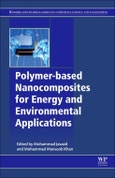Polymer-Based Nanocomposites for Energy and Environmental Applications provides a comprehensive and updated review of major innovations in the field of polymer-based nanocomposites for energy and environmental applications. It covers properties and applications, including the synthesis of polymer based nanocomposites from different sources and tactics on the efficacy and major challenges associated with successful scale-up fabrication. The chapters provide cutting-edge, up-to-date research findings on the use of polymer based nanocomposites in energy and environmental applications, while also detailing how to achieve material's characteristics and significant enhancements in physical, chemical, mechanical and thermal properties.
It is an essential reference for future research in polymer based nanocomposites as topics such as sustainable, recyclable and eco-friendly methods for highly innovative and applied materials are current topics of importance.
Please Note: This is an On Demand product, delivery may take up to 11 working days after payment has been received.
Table of Contents
1. Introduction of polymer based nanocomposites 2. Survey of polymer based nanocomposites 3. Polymer based nanocomposites for significantly enhanced dielectric properties and energy storage capability 4. Graphene based nanocomposites for Energy and Environmental applications 5. Polymer based nanocomposites for significantly enhanced dielectric properties and energy storage capability 6. Polymer nanocomposites for energy storage devices 7. Polymer nanocomposites for sensor devices 8. Polyaniline-based nanocomposites for hydrogen storage 9. Properties and Applications of Polymer nanocomposite materials in energy storage 10. Polymer nanocomposites for lithium battery applications 11. Modification of Polymer Nanocomposites and Significance of Ionic Liquid for Supercapacitors Application 12. Composite Carbon Nanofibers for Na-ion Batteries 13. Nanofibrous Composites in Sensitized Solar Cells 14. Development of polymer nanocomposites using cellulose/silver for Antifouling applications 15. Nanocomposites membrane for environmental remediation 16. Polymer bionanocomposites for heavy metal removal 17. Polypyrrole-Based nanocomposite adsorbent and its applications in removal of radioactive materials 18. Polymer nanocomposites application in sorption processes for removal of environmental contaminants 19. Hybrid materials based on polymer nanocomposites for environmental applications 20. Recent Advances in Nanofibrous Composite Air Filters 21. Polymer nanocomposites for water treatments 22. Recent Advances in Polyaniline based nanocomposites as Potential Adsorbents for trace metal ions 23. Green polymer nanocomposites and their environmental applications 24. CNT Nanocomposites for Wind Turbine Applications
Authors
Mohammad Jawaid Senior Fellow (Professor), Biocomposite Technology Laboratory, Institute of Tropical Forestry and Forest Products (INTROP), Universiti Putra Malaysia, Serdang, Selangor, Malaysia. Dr. Mohammad Jawaid is currently working as a Fellow Researcher (Associate Professor), at the Biocomposite Technology Laboratory, Institute of Tropical Forestry and Forest Products (INTROP), Universiti Putra Malaysia, Serdang, Selangor, Malaysia and has also been a Visiting Professor in the Department of Chemical Engineering, College of Engineering, King Saud University, Riyadh, Saudi Arabia since June 2013. He is also a Visiting Scholar at TEMAG Labs, Department of Textile Engineering, Istanbul Technical University, Turkey. Previously he worked as a Visiting Lecturer, at the Faculty of Chemical Engineering, Universiti Teknologi Malaysia (UTM) and also worked as an Expatriate Lecturer under the UNDP project with the Ministry of Education of Ethiopia at Adama University, Ethiopia. He received his Ph.D. from the Universiti Sains Malaysia, Malaysia. He has more than 10 years of experience in teaching, research, and with industry. His research interests include Hybrid Reinforced/Filled Polymer Composites, Advance Materials: Graphene/Nanoclay/Fire Retardant, Lignocellulosic Reinforced/Filled Polymer Composites, Modification and Treatment of Lignocellulosic Fibres and Solid Wood, Nano Composites and Nanocellulose fibres, and Polymer blends. So far he has published 5 books, 12 book chapters, and more than 130 International journal papers and 4 Published review papers in the Top 25 hot articles on Science Direct during 2014-2015. He is also the Deputy Editor-in-Chief of the Malaysian Polymer Journal and Guest Editor for Current Organic Synthesis and Current Analytical Chemistry. He is the reviewer of several high impact ISI journals (44 Journals). Mohammad Mansoob Khan Associate Professor, Faculty of Science, Universiti Brunei Darussalam, Brunei Darussalam. Mohammad Mansoob Khan is a Professor of Inorganic Chemistry at Chemical Sciences, Faculty of Science, Universiti Brunei Darussalam, Brunei Darussalam. He earned his PhD from Aligarh Muslim University, Aligarh, India, in 2002. He has worked in India, Ethiopia, Oman and South Korea and has established excellence in teaching and novel research. He used to teach various courses at undergraduate and postgraduate levels. He has edited three books and authored one book. He has published about 130 research and review articles.His expertise are in the cutting-edge area of nanochemistry, nanosciences, nanotechnology, materials sciences and materials chemistry especially in the field of inorganic and nanohybrid materials such as synthesis of noble metal nanoparticles, their nanocomposites, metal oxides (such as TiO2, ZnO, SnO2, CeO2 etc.) and chalcogenides (such as CdS, ZnS, MoS2 etc.). He is also extensively working on the band gap engineering of semiconductors (such as metal oxides and chalcogenides). The synthesized nanostructured materials are used for heterogeneous photocatalysis, hydrogen production, photoelectrodes, solar cells, sensors, and biological applications such as antibacterial, antifungal, antibiofilm activities etc.








